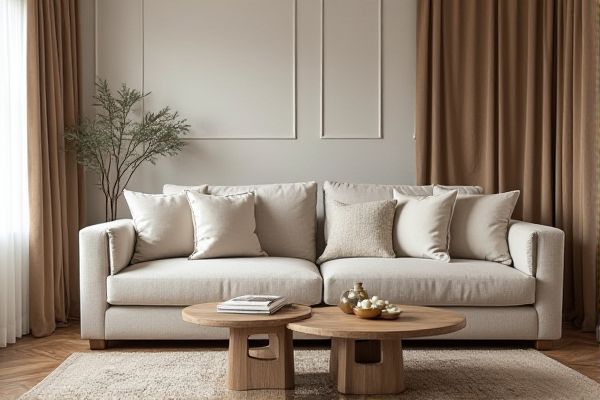
A loveseat is a small sofa designed primarily for two people, offering a cozy seating option often found in living rooms, while a settee typically refers to a longer, upholstered bench-like seat with a back and arms, blending both traditional and contemporary styles. Explore the rest of the article to understand which piece fits your space and aesthetic preferences best.
Table of Comparison
| Feature | Loveseat | Settee |
|---|---|---|
| Definition | A small sofa designed for two people. | A long upholstered seat with a back, often antique or decorative. |
| Seating Capacity | 2 people | 2 to 3 people |
| Design Style | Modern, compact, often cushioned | Traditional, ornate, often wooden frame |
| Common Use | Living rooms, small spaces | Entryways, formal rooms |
| Typical Materials | Fabric, leather, foam padding | Wood, fabric, occasionally velvet |
| History | Popular from 19th century to modern day | Originated in 17th century, Victorian era prominence |
Introduction to Loveseat and Settee
A loveseat is a compact sofa designed to comfortably seat two people, often featuring a modern and plush design ideal for small spaces, while a settee is a traditional, upholstered bench with a back and arms, commonly found in classical or vintage interiors. Loveseats emphasize comfort and versatility, making them suitable for contemporary living rooms or cozy nooks, whereas settees serve as elegant seating options in hallways, entryways, or formal settings. Understanding these differences helps you choose the right piece to enhance both style and functionality in your home.
Definition of Loveseat
A loveseat is a compact two-seater sofa designed to comfortably accommodate two people in a cozy space. It typically features padded armrests and a cushioned back, making it ideal for small living rooms, apartments, or intimate seating areas. Your choice between a loveseat and a settee depends on the room size and the desired style, with loveseats offering a more modern and versatile seating option.
Definition of Settee
A settee is a small upholstered seating piece designed for two or more people, often featuring a backrest and armrests. Traditionally, settees have a wooden frame with cushioned seats, combining comfort and style for living rooms or entryways. Unlike loveseats, settees often have a more formal, antique appearance and can accommodate more occupants.
Historical Background
Loveseats originated in the 18th century, designed as compact seating for couples to sit closely, often featuring upholstered wooden frames in Georgian and Victorian styles. The term "settee" traces back to medieval England, initially referring to a long wooden bench with a back, evolving through the centuries into various upholstered forms used in parlors and drawing rooms. Both pieces reflect historical shifts in social customs and interior design, with loveseats emphasizing intimacy and settees representing communal seating.
Design Differences
Loveseats typically feature a compact, cushioned design with a solid back and arms, offering a cozy and contemporary seating option for two people. Settees, on the other hand, often exhibit a more traditional or antique style with higher backs, exposed wooden frames, and intricate detailing, making them both decorative and functional. Your choice between a loveseat and settee will depend on whether you prefer modern comfort or classic elegance in your living space.
Size and Seating Capacity
Loveseats typically measure between 48 to 72 inches in width and are designed to comfortably seat two people, making them ideal for small living spaces or intimate seating areas. Settees vary more in size but generally range from 50 to 80 inches and can accommodate two to three people, often featuring a more upright back and slender frame. The loveseat emphasizes compact comfort, while the settee combines modest seating capacity with a traditional or vintage aesthetic.
Material and Upholstery Options
Loveseats often feature a variety of upholstery options, including durable fabrics like microfiber, leather, and velvet, designed to provide comfort and longevity in frequently used spaces. Settees tend to showcase elegant materials such as linen, silk blends, or finely woven cotton, emphasizing a refined aesthetic suited for formal settings. When choosing the right piece for Your space, consider the material's texture, durability, and maintenance needs to balance style with practicality.
Best Spaces for Loveseats
Loveseats are ideal for small living rooms, apartments, and cozy reading nooks where maximizing seating without overwhelming the space is essential. Their compact size makes them perfect for paired seating in bedrooms or home offices, providing comfort without dominating the room. Loveseats work well in open-plan layouts as complementary furniture alongside larger sofas or sectionals, creating intimate conversation areas.
Ideal Uses for Settees
Settees are ideal for creating intimate seating areas in smaller spaces such as entryways, bedrooms, or cozy living rooms, offering both comfort and style. Their slender design and back support make them perfect for conversation nooks or window seating where you want to relax and enjoy your surroundings. Your settee can also serve as an elegant accent piece that enhances traditional or vintage-inspired decor with its classic lines and structure.
Choosing Between Loveseat and Settee
Choosing between a loveseat and a settee depends on your space and style preferences. Loveseats typically offer a compact, cushioned seating solution designed for two people, making them ideal for modern living rooms or cozy corners. Settees often provide a more elegant, vintage-inspired look with higher backs and arms, perfect for adding character and charm to traditional or formal settings, ensuring your seating aligns with your room's aesthetic and functional needs.
 homyna.com
homyna.com